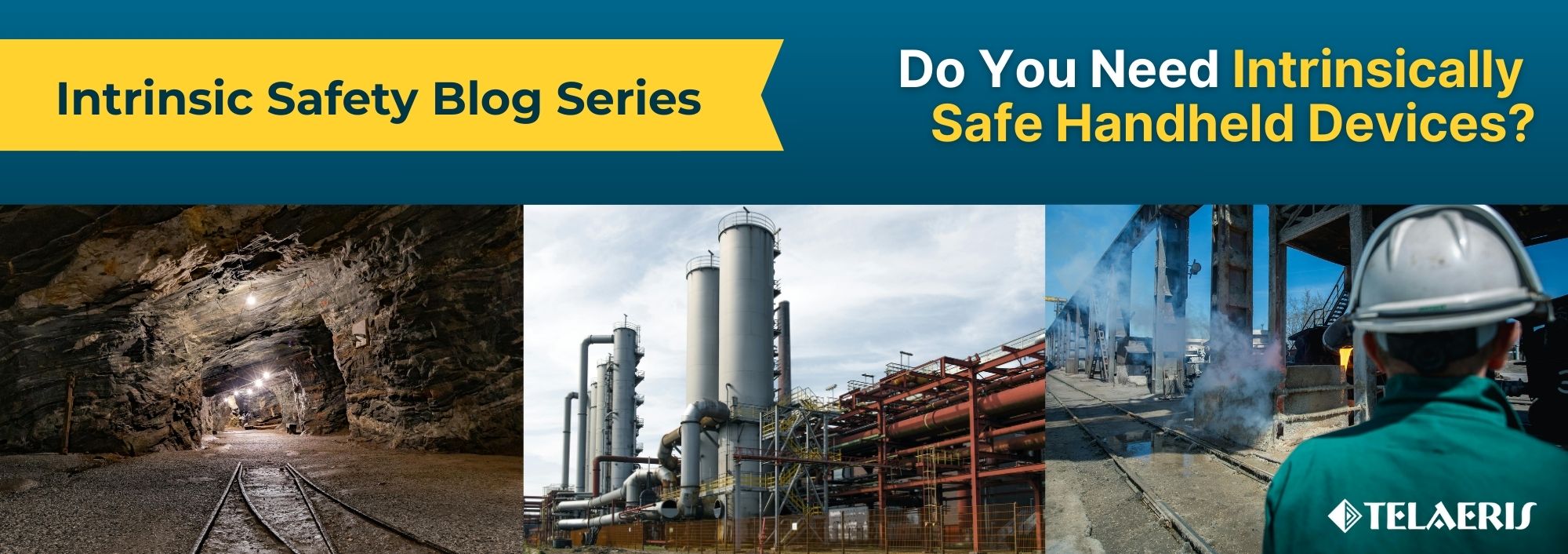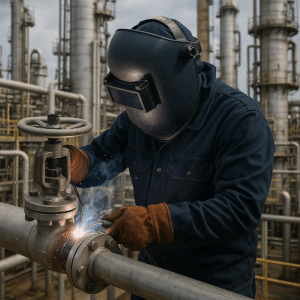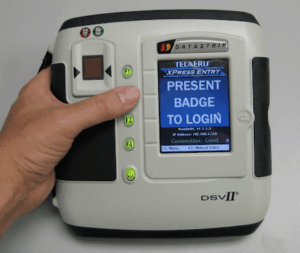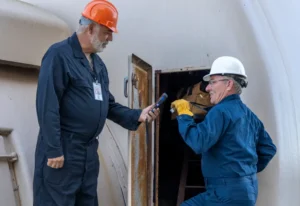
Do You Actually Need Intrinsically Safe Devices for Access Control and Emergency Mustering?
The project that launched Telaeris into the business of handheld devices back in 2007, at first glance, would require an intrinsically safe device. Click here to read an overview of intrinsic safety.
The BP refinery in Carson was conducting turnaround work on a 120 ft Hydrodesulfurization (HDS) reactor and wanted to track up to 500 contractors working inside a permit-required confined space. Given that both hydrogen sulfide and hydrogen are capable of forming explosive mixtures with air, the EHS team naturally thought they would require Class 1/Div 1 intrinsically safe devices for this project.

However, as we performed our investigations on the project, some things didn’t add up. Welders would be working deep in the unit, repairing and replacing pipes and valves; there was no way they would have been able to do this with any hint of a volatile gas! We spoke to the fire marshal in charge of the site, and he had a great explanation. The process unit being worked on would be fully depressurized and purged, with the unit fully isolated using lockout/tagout procedures. With all measures in place, electronic equipment, such as our handheld badge reader, could be safely used in areas that would otherwise require the highest level of safety.

With full approval from the fire and EHS departments, we successfully deployed our first handheld system. Workers were checked in and out at 13 entry ways by safety personnel, providing live accountability and reporting to the BP Safety team.
In this specific situation, we determined there was no need for an intrinsically safe solution. Still, there are other cases when IS might be required for emergency mustering or worker identification.
Where Are Intrinsically Safe (IS) Devices Required?
Intrinsically safe equipment is used in environments where flammable substances are present. Below is a list of industries and specific areas where those substances may be present:
| Industry | Specific Area | Hazardous Substances |
| Mining | Shafts, tunnels, and extraction zones | Methane gas, coal dust |
| Manufacturing | Paint booths, mixing rooms, sanding/grinding stations | Solvents, paints, fine metal, or plastic dust |
| Grain Processing/Storage | Silos, elevators, enclosed conveyors | Grain dust |
| Oil & Gas Refineries | Processing units, storage tanks, transfer lines | Methane, butane, hydrogen sulfide, VOCs |
| Chemical Plants | Mixing rooms, reaction vessels, storage areas | Acetone, benzene, ammonia, volatile chemicals |
| Aviation (Aircraft Hangars) |
Fuel storage bays, maintenance areas | Jet fuel vapors, hydraulic fluids |
| Hydrogen Production Facilities | Electrolyzers, storage, and transfer areas | Hydrogen gas |
| Wastewater Treatment Plants | Anaerobic digesters, sludge handling areas | Methane, hydrogen sulfide |
| Table 1: Locations requiring intrinsic safety | ||
If you are operating in or near these areas, intrinsic safety will be a requirement! If explosive atmospheres are a possibility, equipment and tools must be approved and certified to a strict safety standard.
Imagine a scenario where workers need to check an area for a potential gas leak. The lives of the team and those nearby could be at risk if an inadvertent spark were to occur. In this case, working with an intrinsically safe device not only makes sense but is the only option for the safety of all involved.

Where are Intrinsically Safe (IS) devices likely not required?
There are many times when work is being performed in facilities with risks of explosions, as listed in Table 1. However, most of these high-risk areas are not intended for continuous occupation and would not be suitable for the use of electronic equipment. These are some simple questions that likely indicate whether you require Intrinsically Safe equipment:
- Are vehicles permitted? Running vehicles are not used in explosive environments.
- Do you have a local generator running? Like vehicles, anything with a spark plug or battery would be a potential problem around explosive substances.
- Are personal cell phones allowed? No commercial cell phones are certified as IS. Of course, just because you see someone using a cell phone doesn’t necessarily mean it is safe to do so!
- Is there hot work being done? Burning, welding, soldering, grinding, and other hot work activities pose a dangerous source of ignition.
- Are there groups of people working/assembling without respiratory PPE? Gases, chemicals, dusts, and aerosolized liquids are hazardous to people. If people aren’t strongly protected against these, you likely do not need IS.
Intrinsically Safe (IS) Devices for Emergency Mustering

In most cases where our XPressEntry handheld badge readers are used for secure identification, work certification, or emergency accountability, only a few instances actually require IS certification, even when it was initially thought to have been required.
Of course, the most critical use case is evacuation management. In emergencies, people gather at designated assembly areas / muster points, where they are checked in and accounted for. By design, these assembly points are placed in safe, open areas away from potential hazards, such as parking lots, open fields, or designated shelters—not environments with an explosive atmosphere.
Keep in mind, however, that emergencies are unpredictable, and each situation and facility has unique requirements. For example, if workers need to pass through dangerous areas to reach the assembly point, an intrinsically safe solution may be necessary to ensure a safe evacuation.
In this blog, we focused on how to determine where IS devices are or are not required. In our next blog, we discuss the challenges of reading badges in hazardous areas, the difficulty of finding truly certified solutions, and two companies that we trust to put our software in when Intrinsic Safety is a must. Click here to read about the IS solutions we offer for mobile identification in hazardous areas.
